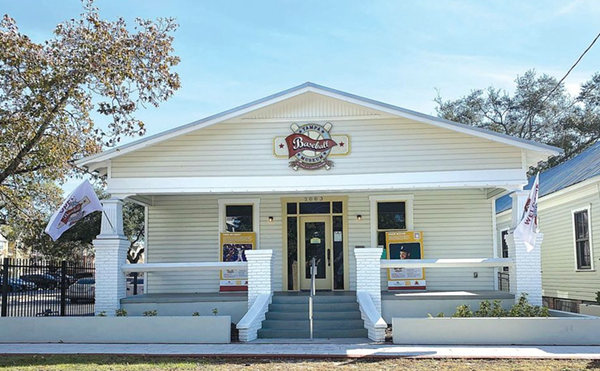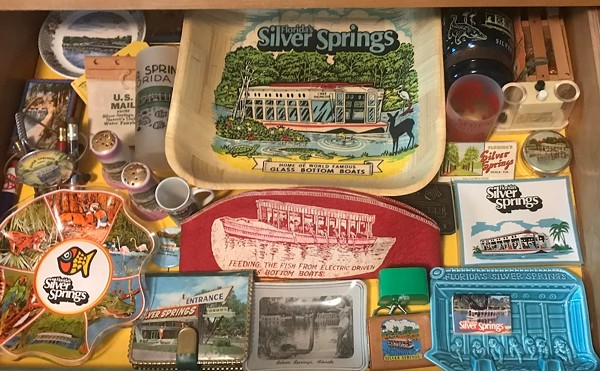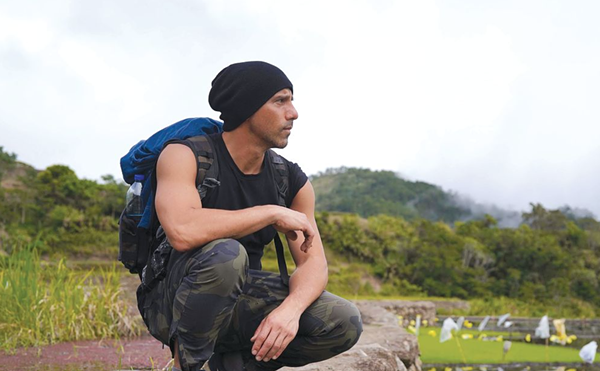Lakeland's Polk Museum of Art rarely disappoints me. Its new exhibition, The Contemporary Tableau: Beal, Goodman, Leslie and Witkin, is no exception.
Of these four well-known realist painters, born between 1927 and 1939, and still going strong, I was more familiar with Alfred Leslie and his monumental portraits. Until now. After crisscrossing the two galleries, comparing painting styles and subjects, my interest in the other three — Jack Beal, Sidney Goodman and Jerome Witkin — was definitely piqued.
So I couldn't help myself. I sat on a bench and scanned books on each of the artists — not because I had to, but because I was so interested in these painters and their art.
Of 28 works, most are large-scale figurative paintings. There are also single portraits or groups, a few small charcoals and pastels, and a still life. The exhibition reads like a psychological smorgasbord, with subjects ranging from the banal to the quirky, from a compulsively painted landscape with mysteriously frozen-in-time figures to compelling social commentary, from curious, gravity-defying angst to the horrific. It's a wonder that the works congeal into a reasonably cohesive show; but they do, despite several choices on the fringe of the central tableau theme which dilute the overall impact. These sidesteps did not dampen my enthusiasm for the exhibition developed by guest curator Dr. August Freundlich, former Dean of USF's College of Fine Arts.
We learn from the wall text that "tableau" — according to Webster's — is a "stage scene in which costumed actors neither speak nor move." Its rich art historical origins began during the Renaissance when Leonardo da Vinci used chiaroscuro drawing techniques — the dramatic lights and darks that lend intensity to imagery. In 17th century Italy, Caravaggio painted an interior light source to dramatize his theatrically staged narratives, typically set in a circular composition. They were innovative and influential. Beal's allegorical "Prudence, Avarice, Lust, Justice, Anger" (1977-78), a contemporary twist on a morality theme, draws significantly from the Caravaggio-esque tradition.
Bay area art enthusiasts may be familiar with the tableau concept through St. Pete's James Michaels, whose masterfully composed Biblical allegory, the monochromatic "The Stoning of St. Stephen," is also one of his best paintings. On the international scene, Moriko Mori's Technicolor scenarios are also lit with the kind of theatricality that first interested Dr. Freundlich to focus on contemporary tableau.
At the Polk, Alfred Leslie, the oldest of the group, is represented by three large single-figure portraits, each posed against a background without pattern or objects. This dramatic portrait style evolved after he abandoned abstraction and his influential avant-garde filmmaking during the late 1950s.
In Leslie's painting of "Dina Cheyette" (1974-75), an awkward teenage girl with oversize hands and feet appears sculptural and wooden, in part resulting from the extreme artificiality of a light source from below. A later painting of a lovely aging woman with a quiet palette is enhanced by simple red lining on the robe and telltale age spots on her face and hands. His self-portraits are also studies in aging. In a younger version (not included here), his wrinkled clothes, open shirt and customary dour face depict the artist as a 1960s painter. In a 1987 version seen here, he's transformed into a handsome gray-haired, self-assured bon vivant with a ticket in his hands. His arty garb is black tie, tux and just a hint of the trendy blue jeans favored by artists. He's arrived. Still, we wonder what's behind such a tight and unrevealing face.
Though biography is only one way to view an artist's work, the information often alters our perception of an image. This happens with the Leslie self-portrait. We learn that during a short, tragic period during the mid-1950s, the artist lost three friends (including Jackson Pollock). Then came a studio fire that destroyed all his art and possessions. Life-altering to be sure. Armed with this knowledge, his expressionless self-portrait seems to change before our eyes.
Sidney Goodman also presents himself in various poses. Critic Gerrit Henry once described him as "a modern master of the horrific ... [whose paintings contain] indecipherable yet depressing and disturbing messages." We'd be hard-pressed to reach that conclusion from this show, though "Self-Portrait with Caution Tape," (1997-99) and "Levitating Man" (2001) reveal the artist's ability to convert human emotion into unique and imaginative imagery.
And then there's Jerome Witkin, twin brother of Joel-Peter Witkin, one of the most controversial of contemporary photographers. Again, biography is seductive. Raised Catholic by their mother and with a Jewish father mostly absent during their childhood, the brothers were adults before investigating their missing Jewish heritage. It resurfaces, daringly, ferociously, with Jerome Witkin's six-part series, "Entering Darkness" (2001), with horrific visual narratives relating the true experiences of an American nurse, one of the first to enter the Dachau Concentration Camp. Witkin encodes the unbearable horror of man's inhumanity with a uniquely fluid painting style and strident color that's enhanced by dramatic lighting and an illustrator's hand.
Other paintings are stamped by Witkin's desire to repair, transform and heal the world. He documents the World Trade Center tragedy in one, and in another, a woman lying in the street, wearing a pink suit and pillbox hat — Jackie Kennedy as a homeless person.
In one of the twists and turns in this exhibition, we also meet Witkins' "Jeff Davies," a working man sporting an enormous potbelly. His windbreaker sleeves shimmer in the light, adding a dash of elegant luster to a regular Joe. But something about him gets under our skin and we return repeatedly to explore the wonderful merging of paint quality and persona.
Beal's work is as versatile as the others in style and subject matter. But "The Farm," typical of his late-1970s oeuvre, has a peculiar charm all its own. The scene is so skillfully painted that we can pick out every stalk of grass. The effect is quaintly mesmerizing.
As satisfying as this show is at its best, there are problems with the hanging of some works and with other pieces that appear superfluous. Given the phenomenal sensitivity of Witkins' Holocaust series, for example, one wonders at the logic of placing several small still-life paintings nearby that diminish the intense visceral experience (unless that's the intended logic).
Moreover, while some works by one artist are separated, there are also missed opportunities to link works in ways that would enhance visual enjoyment. Goodman's "Angel," a figure hovering in space, would make a perfect companion piece to his "Levitating Man." Similarly, I would have loved to see Leslie's debonair self-portrait as a counterpoint to Witkin's "Jeff Davies."
Several small charcoals or pastels also seem out of place in this show of large work. Dr. Freundlich and museum curator Todd Behrens explain the realities of mounting an exhibition rather than hosting traveling shows: Lenders (museums, galleries, or individual collectors) are not always willing or able to lend, creating unavoidable last-minute changes.
While you're visiting the Polk, take a peek at Lakeland's decorated swans modeled after Chicago's public art cows. They're quite a sight, all over town. At Lake Morton (near the museum), real swans are oblivious to their giant imitators lining the shore. What a lesson in realism, which, for all its advocates, doesn't really exist. Or does it?
Diversity Within Unity: The Scope of African-American Art in Florida
This is the kind of small exhibition I wish did not need to be mounted but am glad it was. The work proves what we ought to know: that African-American artists working within Florida are more disparate in their artistic process than they are cohesive.
Twelve artists from around the state are included. I was particularly impressed with Tall Rickards' cibachrome prints depicting single figures in night scenes, and Terry Wilson's' beautiful draftsmanship in his pencil-and-oil wash "Self-Portrait." Also look for "She Wears Sheets," one of three "staged" photographs documenting the life of visiting USF professor Nzingah Muhamad. The photographer, represented by a New York gallery, speaks freely of her Brooklyn childhood in a multiracial, polygamous family.
Another Tampa gallery bites the dust
With Hyde Park Fine Arts owner Tim Waad reporting a 60 percent drop in business from the previous year, he'll close the gallery on Jan. 31. Since 1998, HPFA has been one of Tampa's mainstays in the local contemporary art scene. Waad is negotiating to open a HPFA satellite in Centro Ybor with hopes to recruit former assistant manager and curator Kathie Olivas as guest curator.
Adrienne M. Golub can be reached by e-mail at [email protected].

















